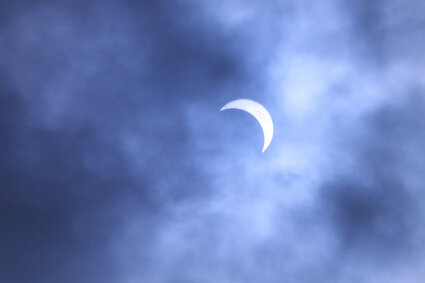Despite clouds, locals catch glimpse of eclipse
Solar event was only partial in NWI
April 11, 2024

LAURA LUX/GALUXY PHOTO
Local photographer Laura Lux, of Hartley, snapped this picture of the partial eclipse Monday afternoon while working at Sybesma Graphics in Sanborn. A tinted window and overcast sky allowed her to take the photo without using a special solar filter for her camera's lens.
One of Mother Nature's most dazzling feats was dulled Monday by one of her more mundane.
Thanks to an overcast sky, the widely-hyped solar eclipse was rendered somewhat invisible depending on your location in northwest Iowa. Those with a completely overcast view noticed a darker sky, but some still caught a glimpse of the phenomenon peaking through the clouds.

IESHA TOFT/SENTINEL-NEWS
With special glasses in place, CC/E first grader Emmett Christensen tries in earnest to view Monday's solar eclipse in Royal.
Elementary students at Clay Central/Everly crowded the school grounds with special glasses to watch the show – or attempted to, at least.
"The clouds may have taken away from their view, but the students will never forget their time heading out with their friends, schoolmates and teachers, trying to view such a fantastic event," said Iesha Toft, CC/E Outreach & Culture Coordinator.
Full solar eclipses are rare and occur when the moon covers the sun, exposing its corona. Monday's eclipse was only partial in northwest Iowa, as those wishing to see it in totality had to be located farther south. Its path in the United States started in southeast Texas and traveled northeast towards Maine.
The last eclipse to happen in the United States was on Aug. 21, 2017; the next will be on Aug. 12, 2045.





